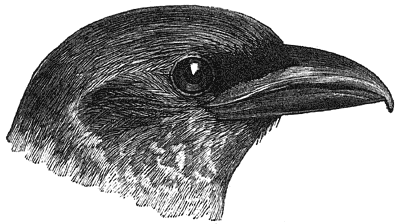Page 03 | prev page next page | ||
Eurylaemus javanicus, Horsfield's Broadbill
Fig. 3 - Eurylaemus javanicus Horsfield's Broadbill Coloration: Male. Whole head and neck deep purplish red, lores blackish, crown and nape very dark, ear-coverts much brighter; a very narrow white line below the eye; hind neck brownish, back and upper tail-coverts mixed black and bright yellow, basal portion of interscapulary feathers white; wings black, each primary with a yellow spot at the base, each secondary with a long yellow spot on the outer web, inner webs of all quills whitish near the base; tail black, all feathers except the middle pair with a subterminal fulvous white spot or band. Lower parts vinaceous red, the throat washed with dusky bronze, a narrow black band across the breast and a distinctly bronzed gorget behind it, lower breast and abdomen brighter red; under wing-coverts mostly yellow, edge of wing the same, thigh-coverts dark brown. Female, similar, but without the black pectoral band. Young birds have the head and nape yellowish brown, the shafts of the feathers brighter yellow; lower plumage yellowish throughout. Upper mandible bright blue to within one-third of tip; rest of upper mandible pale sea-green; lower mandible pale greenish blue; both mandibles edged and tipped with brownish red; irides bright blue; legs and feet fleshy; claws brown (Davison).
Size: Length 9 inches; tail 2.9; wing 4.3; tarsus 1; bill from gape 1.6. The female is slightly smaller. |
| ||
Distribution: Karennee; Tenasserim as far north as Moulmein, probably farther north on the hills to the eastward; Malay peninsula, Sumatra, Java, and Borneo. Habits: This species feeds on insects and small reptiles, and has the typical habits of the family, living in forests in small parties. Davison found it breeding near Bankasun in March; the nest was a massive structure composed of moss, fibres, roots, dry leaves, bits of wood, and small twigs, suspended to the extreme tip of a very tall bamboo overhanging a stream. Two fresh eggs were in the nest, dull white, thickly speckled with minute spots of dusky brown, more thickly towards the large end: size 1.09 by 0.76.
Coloration: Male. Whole head black, except a few white feathers below each eye. A white collar round the neck, narrow behind. Upper parts from neck black, with a bright yellow stripe down the middle of the back, rump, and upper tail-coverts, and a shorter stripe on each side on the outer scapulars; basal portion of interscapulary feathers white; middle of outer webs of secondary quills yellow; near the base almost all wing-feathers have a whitish inner border. A small yellowish spot on each primary near the base; tail-feathers with a subterminal yellowish-white spot on inner web, becoming a band on the outer feathers; a broad black gorget below the white collar, lower breast and abdomen pale vinous purple; under wing-. and tail-coverts, vent, flanks, and edge of wing yellow; thigh-coverts black. Female, similar, but the black gorget is interrupted in the middle. The young have the forehead and supercilia yellowish white; the throat whitish, breast and abdomen yellowish grey. Lower mandible and base of upper bright smalt-blue, rest of upper mandible bright green; edges of both mandibles black; irides bright yellow; legs and feet dark but fleshy-pink; claws brown (Davison). Size: Length 6.5; tail 2.2; wing 3.3; tarsus 0.8; bill from gape 1.1
Distribution: South Tenasserim as far north as Yay, Malay peninsula, Sumatra and Borneo. | |||
| prev page :: next page | |||
 birding.in
birding.in
| Birds | Bird Diagram | Ornithology | Indian Sites | Bird Watching | Migration | North India | Birds of India | Haryana |
All rights reserved. Copyright © 2005-2013 Birds and birding in India. Disclaimer
website: Free Java Guide & Tutorials
